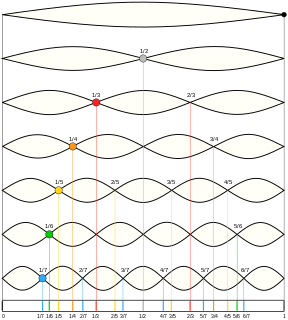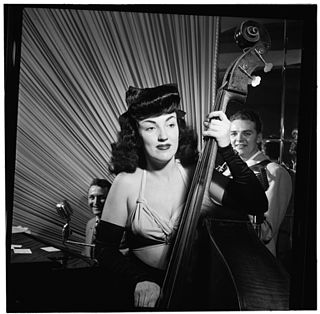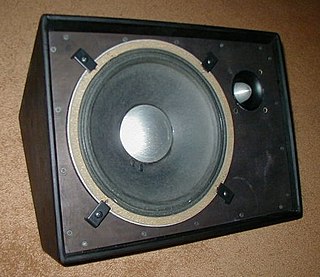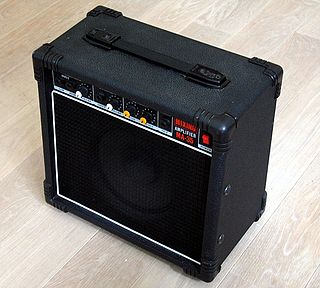Related Research Articles

Bass ( BAYSS) (also called bottom end) describes tones of low (also called "deep") frequency, pitch and range from 16 to 256 Hz (C0 to middle C4) and bass instruments that produce tones in the low-pitched range C2-C4. They belong to different families of instruments and can cover a wide range of musical roles. Since producing low pitches usually requires a long air column or string, and for stringed instruments, a large hollow body, the string and wind bass instruments are usually the largest instruments in their families or instrument classes.

A harmonic series is the sequence of harmonics, musical tones, or pure tones whose frequency is an integer multiple of a fundamental frequency.

A harmonic is a wave with a frequency that is a positive integer multiple of the fundamental frequency, the frequency of the original periodic signal, such as a sinusoidal wave. The original signal is also called the 1st harmonic, the other harmonics are known as higher harmonics. As all harmonics are periodic at the fundamental frequency, the sum of harmonics is also periodic at that frequency. The set of harmonics forms a harmonic series.

A subwoofer is a loudspeaker designed to reproduce low-pitched audio frequencies known as bass and sub-bass, lower in frequency than those which can be (optimally) generated by a woofer. The typical frequency range for a subwoofer is about 20–200 Hz for consumer products, below 100 Hz for professional live sound, and below 80 Hz in THX-certified systems. Subwoofers are never used alone, as they are intended to augment the low-frequency range of loudspeakers that cover the higher frequency bands. While the term "subwoofer" technically only refers to the speaker driver, in common parlance, the term often refers to a subwoofer driver mounted in a speaker enclosure (cabinet), often with a built-in amplifier.
Multichannel Television Sound, better known as MTS, is the method of encoding three additional audio channels into an analog NTSC-format audio carrier. It was developed by the Broadcast Television Systems Committee, an industry group, and sometimes known as BTSC as a result.
The low-frequency effects (LFE) channel is a band-limited audio track that is used for reproducing deep and intense low-frequency sounds in the 3–120 Hz frequency range.

A harmonic sound is said to have a missing fundamental, suppressed fundamental, or phantom fundamental when its overtones suggest a fundamental frequency but the sound lacks a component at the fundamental frequency itself. The brain perceives the pitch of a tone not only by its fundamental frequency, but also by the periodicity implied by the relationship between the higher harmonics; we may perceive the same pitch even if the fundamental frequency is missing from a tone.

Low-frequency oscillation (LFO) is an electronic frequency that is usually below 20 Hz and creates a rhythmic pulse or sweep. This is used to modulate musical equipment such as synthesizers to create audio effects such as vibrato, tremolo and phasing.
In electronics, a frequency multiplier is an electronic circuit that generates an output signal and that output frequency is a harmonic (multiple) of its input frequency. Frequency multipliers consist of a nonlinear circuit that distorts the input signal and consequently generates harmonics of the input signal. A subsequent bandpass filter selects the desired harmonic frequency and removes the unwanted fundamental and other harmonics from the output.
Sensurround is the brand name for a process developed by Cerwin-Vega in conjunction with Universal Studios to enhance the audio experience during film screenings, specifically for the 1974 film Earthquake. The process was intended for subsequent use and was adopted for four more films, Midway (1976), Rollercoaster (1977), the theatrical version of Saga of a Star World (1978), the Battlestar Galactica pilot, as well as the compilation film Mission Galactica: The Cylon Attack (1979). Sensurround worked by adding extended-range bass for sound effects. The low-frequency sounds were more felt than heard, providing a vivid complement to onscreen depictions of earth tremors, bomber formations, and amusement park rides. The overall trend toward "multiplex" cinema structures presented challenges that made Sensurround impractical as a permanent feature of cinema.

Sub-bass sounds are the deep, low-register pitches below approximately 70 Hz (C♯2 in scientific pitch notation) and extending downward to include the lowest frequency humans can hear, approximately 20 Hz (E0).
The harmonic mixer and subharmonic mixer are a type of frequency mixer, which is a circuit that changes one signal frequency to another. The ordinary mixer has two input signals and one output signal. If the two input signals are sinewaves at frequencies f1 and f2, then the output signal consists of frequency components at the sum f1+f2 and difference f1−f2 frequencies. In contrast, the harmonic and subharmonic mixers form sum and difference frequencies at a harmonic multiple of one of the inputs. The output signal then contains frequencies such as f1+kf2 and f1−kf2 where k is an integer.
Bandwidth extension of signal is defined as the deliberate process of expanding the frequency range (bandwidth) of a signal in which it contains an appreciable and useful content, and/or the frequency range in which its effects are such. Its significant advancement in recent years has led to the technology being adopted commercially in several areas including psychacoustic bass enhancement of small loudspeakers and the high frequency enhancement of coded speech and audio.
In music, the undertone series or subharmonic series is a sequence of notes that results from inverting the intervals of the overtone series. While overtones naturally occur with the physical production of music on instruments, undertones must be produced in unusual ways. While the overtone series is based upon arithmetic multiplication of frequencies, resulting in a harmonic series, the undertone series is based on arithmetic division.
Megasound was the name of a movie theater sound system created by Warner Bros. and was officially deployed during the early 1980s. Warner Bros. used it to provide deep-bass enhancement to premiere engagements for a handful of their features, including:
The fundamental principle of bass management in surround sound replay systems is that bass content in the incoming signal, irrespective of channel, should be directed only to loudspeakers capable of reproducing it, whether the latter are the main system loudspeakers or one or more subwoofers.

Bass traps are acoustic energy absorbers which are designed to damp low frequency sound energy with the goal of attaining a flatter low frequency (LF) room response by reducing LF resonances in rooms. They are commonly used in recording studios, mastering rooms, home theatres and other rooms built to provide a critical listening environment. Like all acoustically absorptive devices, they function by turning sound energy into heat through friction.

A stage monitor system is a set of performer-facing loudspeakers called monitor speakers, stage monitors, floor monitors, wedges, or foldbacks on stage during live music performances in which a sound reinforcement system is used to amplify a performance for the audience. The monitor system allows musicians to hear themselves and fellow band members clearly.

Equalization, or simply EQ in sound recording and reproduction is the process of adjusting the volume of different frequency bands within an audio signal. The circuit or equipment used to achieve this is called an equalizer.

A keyboard amplifier is a powered electronic amplifier and loudspeaker in a wooden speaker cabinet used for amplification of electronic keyboard instruments. Keyboard amplifiers are distinct from other types of amplification systems such as guitar amplifiers due to the particular challenges associated with making keyboards sound louder on stage; namely, to provide solid low-frequency sound reproduction for the deep basslines which keyboards can play and crisp high-frequency sound for the high-register notes. Another difference between keyboard amplifiers and guitar/bass amplifiers is that keyboard amps are usually designed with a relatively flat frequency response and low distortion. In contrast, many guitar and bass amp designers purposely make their amplifiers modify the frequency response, typically to "roll off" very high frequencies, and most rock and blues guitar amps, and since the 1980s and 1990s, even many bass amps are designed to add distortion or overdrive to the instrument tone.
References
- ↑ Brewster, Bill; Broughton, Frank. The Record Players: DJ Revolutionaries. Black Cat. p. 64
- ↑ Krukowski, Damon (17 June 2015). "Drop the Bass: A Case Against Subwoofers". pitchfork.com. Pitchfork. Retrieved 31 December 2018.
- ↑ Lawrence, Tim. “Beyond the Hustle: Seventies Social Dancing, Discotheque Culture and the Emergence of the Contemporary Club Dancer”. In Ballroom, Boogie, Shimmy Sham, Shake: A Social and Popular Dance Reader, ed. Julie Malnig. University of Illinois Press, 2009. p. 204
- ↑ Papenburg, Jens Gerrit. "Enhanced Bass" in Sound as Popular Culture: A Research Companion, edited by Jens Gerrit Papenburg, Holger Schulze. MIT Press, 2016. p. 210
- ↑ "DBX 100 Boom Box Sub Harmonic Synthesizer". www.hifiengine.com. HiFiEngine. Retrieved 2 January 2019.
- Glenn White; Gary J Louie (1 July 2005). The Audio Dictionary: Third Edition, Revised and Expanded. University of Washington Press. p. 50. ISBN 978-0-295-80170-4.